Battles of Khalkhin Gol
The Battles of Khalkhin Gol were the decisive engagements of the undeclared Soviet–Japanese border conflicts fought among the Soviet Union, Mongolia, Japan and Manchukuo in 1939. The conflict was named after the river Khalkhin Gol, which passes through the battlefield. In Japan, the decisive battle of the conflict is known as the Nomonhan Incident (ノモンハン事件, Nomonhan jiken) after Nomonhan, a nearby village on the border between Mongolia and Manchuria. The battles resulted in the defeat of the Japanese Sixth Army.
| Battles of Khalkhin Gol/Nomonhan | |||||||||
|---|---|---|---|---|---|---|---|---|---|
| Part of the Soviet–Japanese border conflicts | |||||||||
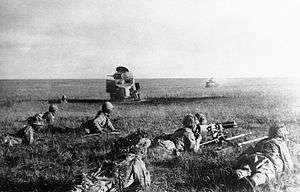 Japanese infantrymen near wrecked USSR armored vehicles, July 1939 | |||||||||
| |||||||||
| Belligerents | |||||||||
|
| |||||||||
| Commanders and leaders | |||||||||
| |||||||||
| Strength | |||||||||
|
61,860–73,961[nb 1]
4,000 trucks[8] 1,921 horses and camels (Mongol only)[9] |
c. 20,000–30,000[10][11]
1,000 trucks[12] 2,708 horses[13] | ||||||||
| Casualties and losses | |||||||||
|
Manpower: Equipment: 208 aircraft[16] 253 tanks destroyed[17] 133 armored cars destroyed 96 mortars and artillery 49 tractors and prime movers 652 trucks and other motor vehicles[14][15] significant animal casualties[18] |
Manpower: Equipment: 160 aircraft[16] 29 tanks destroyed or crippled[5] Many tankettes destroyed 72 artillery pieces (field guns only)[21] 2,330 horses killed, injured, or sick[13] significant motor vehicle losses[22] | ||||||||
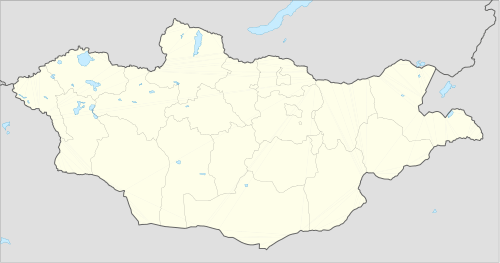 Khalkhin Gol/Nomonhan Location within Mongolia 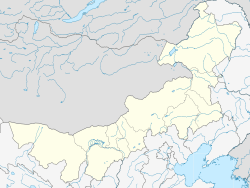 Khalkhin Gol/Nomonhan Khalkhin Gol/Nomonhan (Inner Mongolia) | |||||||||
Background
After the Japanese occupation of Manchuria in 1931, Japan turned its military interests to Soviet territories that bordered those areas. The first major Soviet-Japanese border incident, the Battle of Lake Khasan, occurred in 1938 in Primorye. Clashes between Japanese and Soviet forces frequently occurred along the border of Manchuria.
In 1939, Manchuria was a puppet state of Japan known as Manchukuo, and Mongolia was a communist state allied with the Soviet Union, known as the Mongolian People's Republic. The Japanese maintained that the border between Manchukuo and Mongolia was the Khalkhin Gol (English "Khalkha River") which flows into Lake Buir. In contrast, the Mongolians and their Soviet allies maintained that the border ran some 16 kilometres (9.9 mi) east of the river, just east of Nomonhan village.[23]
The principal occupying army of Manchukuo was the Kwantung Army of Japan, consisting of some of the best Japanese units in 1939. However, the western region of Manchukuo was garrisoned by the relatively newly formed 23rd Infantry Division at Hailar under General Michitarō Komatsubara and included several Manchukuoan army and border guard units all under the direct command of the Sixth Army. The 23rd was the newest and least experienced division in the entire Kwantung Army. In addition to this, the 23rd Division was equipped with outdated equipment. Japanese army experts rated the combat capability of the 23rd Division as "below medium", comparable to a garrison division on occupation duty in China.[24]
The Soviet forces consisted of the 57th Special Corps, deployed from the Trans-Baikal Military District. They were responsible for defending the border between Siberia and Manchuria. The Mongolian troops mainly consisted of cavalry brigades and light artillery units, and proved to be effective and agile, but lacked armor and manpower in sufficient numbers.
On 2 June 1939 Georgy Zhukov was told by Commissar of Defence Kliment Voroshilov that Stalin was dissatisfied with the local commander and he was to go to Outer Mongolia, take command of the 57th Special Corps and eliminate Japanese provocations by inflicting a decisive reverse on the Imperial Japanese Army (when summoned to Moscow on 1 June he had feared he was to be arrested and interrogated by the NKVD).[25]
In 1939, the Japanese Cabinet sent instructions to the Kwantung Army to strengthen and fortify Manchukuo's borders with Mongolia and the Soviet Union. Additionally, the Kwantung Army, which had long been stationed in Manchuria far from the Japanese Home Islands, had become largely autonomous and tended to act without approval from, or even against the direction of, the Japanese government.[26]
Battles
May: Skirmishes
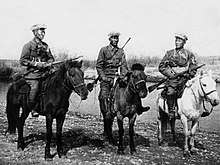

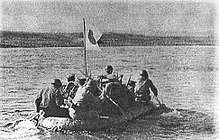
The incident began on 11 May 1939. A Mongolian cavalry unit of some 70–90 men had entered the disputed area in search of grazing for their horses. On that day, Manchukuoan cavalry attacked the Mongolians and drove them back across the river Khalkhin Gol. On 13 May, the Mongolian force returned in greater numbers and the Manchukoans were unable to dislodge them.
On 14 May, Lt. Col. Yaozo Azuma led the reconnaissance regiment of the 23rd Infantry Division, supported by the 64th Infantry Regiment of the same division, under Colonel Takemitsu Yamagata, into the territory and the Mongolians withdrew. Soviet and Mongolian troops returned to the disputed region, however, and Azuma's force again moved to evict them, but the Soviet-Mongolian forces surrounded Azuma's force on 28 May and destroyed it.[27] The Azuma force suffered eight officers and 97 men killed and one officer and 33 men wounded, for 63% total casualties.
The commander of the Soviet forces and the Far East Front was Comandarm Grigori Shtern from May 1938.[28]
June: Escalation
Both sides increased their forces in the area. Soon, Japan had 30,000 men in the theater. The Soviets dispatched a new corps commander, Comcor Georgy Zhukov, who arrived on 5 June and brought more motorized and armored forces (I Army Group) to the combat zone.[29] Accompanying Zhukov was Comcor Yakov Smushkevich with his aviation unit. J. Lkhagvasuren, Corps Commissar of the Mongolian People's Revolutionary Army, was appointed Zhukov's deputy.
On 27 June, the Japanese Army Air Force's 2nd Air Brigade struck the Soviet air base at Tamsak-Bulak in Mongolia. The Japanese won this engagement, but the strike had been ordered by the Kwantung Army without getting permission from Imperial Japanese Army (IJA) headquarters in Tokyo. In an effort to prevent the incident from escalating,[30] Tokyo promptly ordered the JAAF not to conduct any more air strikes against Soviet airbases.[31]
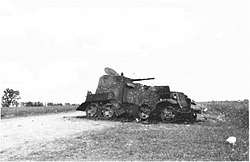
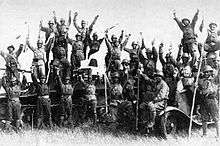
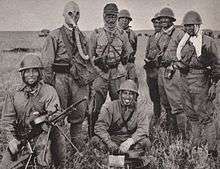
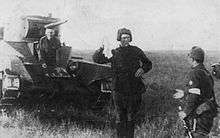
Throughout June, there were reports of Soviet and Mongolian activity on both sides of the river near Nomonhan and small-scale attacks on isolated Manchukoan units. At the end of the month, the commander of the 23rd Japanese Infantry Division, Lt. Gen. Michitarō Komatsubara, was given permission to "expel the invaders".
July: Japanese assault
The Japanese plan was for a two-pronged assault. The first attack would be made by three regiments plus part of a fourth: the 71st and the 72nd Infantry Regiment (23rd Division), a battalion of the 64th Infantry Regiment and the 26th Infantry Regiment under Colonel Shinichiro Sumi (7th Infantry Division). This force would advance across the Khalkin Gol, destroy Soviet forces on Baintsagan Hill on the west bank, then make a left turn and advance south to the Kawatama Bridge. The second prong of the attack would be the task of the IJA 1st Tank Corps (1st TC) (Yasuoka Detachment), consisting of the 3rd and 4th Tank Regiments, plus a part of the 64th Infantry Regiment, a battalion from the 28th Infantry Regiment, detached from the 7th Infantry, 24th Engineer Regiment, and a battalion from the 13th Field-Artillery Regiment, all under the overall command of Lieutenant General Yasuoka Masaomi.[32] This force would attack Soviet troops on the east bank of the Khalkhin Gol and north of the Holsten River. The two Japanese thrusts were to join together on the wings.
- Lt. Gen. Yasuoka Masaomi, IJA, Commanding Officer, 1st Tank Corps[32]
- 3rd Tank Regiment[33]
- Type 89 I-Go medium tanks – 26
- Type 97 Chi-Ha medium tanks – 4
- Type 94 tankettes – 7
- Type 97 Te-Ke tankettes – 4
- 4th Tank Regiment[34]
- Type 95 Ha-Go light tanks – 35
- Type 89 I-Go medium tanks – 8
- Type 94 tankettes – 3
- 3rd Tank Regiment[33]
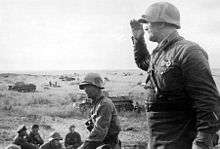
The northern task force succeeded in crossing the Khalkhin Gol, driving the Soviets from Baintsagan Hill, and advancing south along the west bank. However, Zhukov, perceiving the threat, launched a counterattack with 450 tanks and armored cars. The tanks consisted of primarily BTs with a handful of T-26s, while the armored cars were BA-10s and BA-3/6s, which were similar in armor (6–15 mm (0.24–0.59 in)) and armament (main: 45 mm (2 in) gun 20K mod, secondary: two 7.62 mm (0.30 in) machine guns) to the Soviet light tanks. The Soviet armored force, despite being unsupported by infantry, attacked the Japanese on three sides and nearly encircled them. The Japanese force, further handicapped by having only one pontoon bridge across the river for supplies, was forced to withdraw, recrossing the river on 5 July. Meanwhile, the 1st Tank Corps of the Yasuoka Detachment (the southern task force) attacked on the night of 2 July, moving in the darkness to avoid the Soviet artillery on the high ground of the river's west bank. A pitched battle ensued in which the Yasuoka Detachment lost over half its armor, but still could not break through the Soviet forces on the east bank and reach the Kawatama Bridge.[35][36] After a Soviet counterattack on 9 July threw the battered, depleted Yasuoka Detachment back, it was dissolved and Yasuoka was relieved.[37]
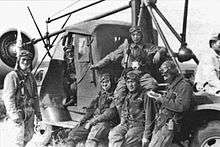
The two armies continued to spar with each other over the next two weeks along a four-kilometre (2.5 mi) front running along the east bank of the Khalkhin Gol to its junction with the Holsten River.[38] Zhukov, whose army was 748 km (465 mi) away from its base of supply, assembled a fleet of 2,600 trucks to supply his troops, while the Japanese suffered severe supply problems due to a lack of similar motor transport.[31] On 23 July, the Japanese launched another large-scale assault, sending the 64th and 72nd Infantry Regiments against Soviet forces defending the Kawatama Bridge. Japanese artillery supported the attack with a massive barrage that consumed more than half of their ammunition stores over a period of two days.[39] The attack made some progress but failed to break through Soviet lines and reach the bridge. The Japanese disengaged from the attack on 25 July due to mounting casualties and depleted artillery stores. By this point they had suffered over 5,000 casualties between late May and 25 July, with Soviet losses being much higher but more easily replaced.[31][40] The battle drifted into a stalemate.
August: Soviet counterattack
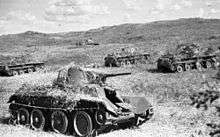
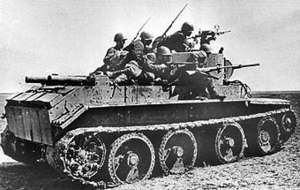
With war apparently imminent in Europe, Zhukov planned a major offensive on 20 August to clear the Japanese from the Khalkhin Gol region and end the fighting.[41] Zhukov, using a fleet of at least 4,000 trucks (IJA officers with hindsight dispute this, saying he instead used 10,000 to 20,000 motor vehicles) transporting supplies from the nearest base in Chita (600 kilometres (370 mi) away)[8] assembled a powerful armored force of three tank brigades (the 4th, 6th and 11th), and two mechanized brigades (the 7th and 8th, which were armored-car units with attached infantry support). This force was allocated to the Soviet left and right wings. The entire Soviet force consisted of three rifle divisions, two tank divisions and two more tank brigades (in all, some 498 BT-5 and BT-7 tanks),[42] two motorized infantry divisions, and over 550 fighters and bombers.[43] The Mongolians committed two cavalry divisions.[44][45][46]
In comparison, at the point of contact, the Kwantung Army had only General Komatsubara's 23rd Infantry Division, which with various attached forces was equivalent to two light-infantry divisions. Its headquarters had been at Hailar, over 150 km (93 mi) from the fighting. Japanese intelligence, despite demonstrating an ability to track the build-up of Zhukov's force accurately, failed to precipitate an appropriate response from below.[47] Thus, when the Soviets finally did launch their offensive, Komatsubara was caught off guard.[47][48] To test the Japanese defences prior to their main assault on 20 August, the Soviets launched three aggressive probing assaults, one on 3 August and the others on 7/8 August. All three were disastrously thrown back, with around 1,000 combined dead and several tanks knocked out on the Soviet side compared to just 85 Japanese casualties.[49] Moreover, the Japanese counter-attacked and routed elements of the Mongolian 8th Cavalry Division, seizing a hilly sector of the battlefront.[50] Despite the fact that no more major fighting would take place until 20 August, Japanese casualties continued to mount at a rate of 40 wounded per day.[51] Kwantung Army staff officers were becoming increasingly worried over the disorganized state of the 6th Army's headquarters and supply elements. In addition, the growing casualty count meant that the already green 23rd Division would have to take, train, and assimilate new replacements "on the job".[51] By contrast, Tokyo's oft-stated desire that it would not escalate the fighting at Khalkhin-Gol proved immensely relieving to the Soviets, who were free to hand-pick select units from across their entire military to be concentrated for a local offensive without fear of Japanese retaliation elsewhere.[52]
Zhukov decided it was time to break the stalemate.[43] At 05:45 on 20 August 1939, Soviet artillery and 557 aircraft[43] attacked Japanese positions, the first fighter-bomber offensive in Soviet Air Force history.[53] Approximately 50,000 Soviet and Mongolian soldiers of the 57th Special Corps attacked the east bank of the Khalkhin Gol. Three infantry divisions and a tank brigade crossed the river, supported by massed artillery and the Soviet Air Force. Once the Japanese were pinned down by the attack of Soviet center units, Soviet armored units swept around the flanks and attacked the Japanese in the rear, achieving a classic double envelopment. When the Soviet wings linked up at Nomonhan village on 25 August, the Japanese 23rd Infantry Division was trapped.[31][54][55] On 26 August, a Japanese counterattack to relieve the 23rd Division failed. On 27 August, the 23rd Division attempted to break out of the encirclement, but also failed. When the surrounded forces refused to surrender, they were again hit with artillery and air attacks. By 31 August, Japanese forces on the Mongolian side of the border were destroyed, leaving remnants of the 23rd Division on the Manchurian side. The Soviets had achieved their objective.[56]
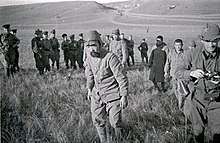
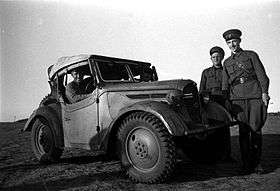
Komatsubara refused to accept the outcome and prepared a counteroffensive. This was canceled when a cease-fire was signed in Moscow. While Zhukov defeated the Japanese forces on "Soviet territory", Joseph Stalin had made a deal with Nazi Germany.[43] After the Soviet success at Nomonhan, Stalin decided to proceed with the Molotov–Ribbentrop Pact, which was announced on 24 August.
The Soviet Union and Japan agreed to a cease-fire on 15 September, which took effect the following day at 1:10 pm.[31][57][58] Free from a threat in the Far East, Stalin proceeded with the Soviet invasion of Poland on 17 September.[59]
Aftermath
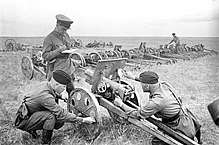
Japanese records report 8,440 killed, 8,766 wounded, 162 aircraft lost in combat, and 42 tanks lost (of which 29 were later repaired and redeployed). Roughly 3,000 Manchukuoan and Japanese troops were taken prisoner during the battles. Due to a military doctrine that prohibited surrender, the Japanese listed most of these men as killed in action, for the benefit of their families.[60] Some sources put the Japanese casualties at 45,000 or more killed, with Soviet casualties of at least 17,000.[31] However, these estimates for Japanese casualties are considered inaccurate as they exceed the total strength of the Japanese forces involved in the battle (estimated at 28,000–40,000 troops, despite Soviet claims that they were facing 75,000).[61] [62] According to the records of the Bureau 6A hospital, the Japanese casualties amounted to 7,696 killed, 8,647 wounded, 1,021 missing, and 2,350 sick, for a total of 19,714 personnel losses, including 2,895 Manchukuoan casualties. The Kwantung Army headquarters and their records give a slightly different figure of 8,629 killed and 9,087 injured. The former Japanese Minister of agriculture and forestry estimated a total of 35000 to 36000 casualties [63] The Soviets initially claimed to have inflicted 29,085 casualties on the Japanese, but later increased this to 61,000 for the official histories.[2]
The Soviets initially claimed 9,284 total casualties, which was almost certainly reduced for propaganda purposes. In recent years, with the opening of the Soviet archives, a more accurate assessment of Soviet casualties has emerged from the work of Grigoriy Krivosheev, citing 7,974 killed and 15,251 wounded.[64] In the newer, 2001 edition, the Soviet losses are given as 9,703 killed and missing (6,472 killed and died of wounds during evacuation, 1,152 died of wounds in hospitals, 8 died of disease, 2,028 missing, 43 non-combat dead), 15,952 wounded and sick, and a further 2,225 hospitalizations due to disease, a total of 27,880 casualties.[65] In addition to their personnel losses, the Soviets lost a large amount of materiel including 253 tanks, 250 aircraft (including 208 in combat), 96 artillery pieces, and 133 armored cars. Of the Soviet tank losses, 75–80% were destroyed by anti-tank guns, 15–20% by field artillery, 5–10% by infantry-thrown incendiary bombs, 2–3% by aircraft, and 2–3% by hand grenades and mines.[15] The large number of Soviet armor casualties are reflected in the manpower losses for Soviet tank crews. A total of 1,559 Soviet "Tank Troops" were killed or wounded during the battles.[66]
Mongolian casualties were 556–990, with at least 11 armored cars destroyed and 1,921 horses/camels lost.[67]
Nomonhan was the first use of airpower on a massive scale in a high-intensity battle to obtain a specific military objective.[68] The combatants remained at peace until August 1945, when the Soviet Union declared war on Japan and invaded Manchukuo and other territory after the atomic bombing of Hiroshima.
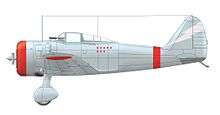
Air combat
Soviet aircraft losses
| I-16 fighter | I-15 biplane fighter | I-153 biplane fighter | SB high-speed bomber | TB-3 heavy bomber | R-5 reconnaissance aircraft | Total: | |
|---|---|---|---|---|---|---|---|
| Combat losses | 87 | 60 | 16 | 44 | 0 | 1 | 208 |
| Non-Combat losses | 22 | 5 | 6 | 8 | 1 | 0 | 42 |
| Total losses | 109 | 65 | 22 | 52 | 1 | 1 | 250 |
| Ref[16] | |||||||
Japanese aircraft losses
| Ki-4 reconnaissance aircraft | Ki-10 biplane fighter | Ki-15 reconnaissance | Ki-21 high speed bomber | Ki-27 fighter | Ki-30 light bomber | Ki-36 utility aircraft | Fiat BR.20 medium bomber | Transport aircraft | Total | |
|---|---|---|---|---|---|---|---|---|---|---|
| Aerial combat losses | 1 | 1 | 7 | 3 | 62 | 11 | 3 | 0 | 0 | 88 |
| Write-offs due to combat damage | 14 | 0 | 6 | 3 | 34 | 7 | 3 | 1 | 6 | 74 |
| Total combat losses | 15 | 1 | 13 | 6 | 96 | 18 | 6 | 1 | 6 | 162 |
| Combat damage | 7 | 4 | 23 | 1 | 124 | 33 | 6 | 20 | 2 | 220 |
| Ref[16] | ||||||||||
Aircraft losses summary and notes
Combat losses include aircraft shot down during aerial combat, written off due to combat damage or destroyed on the ground.
Non-combat losses include aircraft that were lost due to accidents, as well as write-offs of warplanes due to the end of their service life. Thus Soviet combat losses amount to 163 fighters, 44 bombers, and a reconnaissance aircraft, with further 385 fighters and 51 bombers requiring repairs due to combat damage. VVS (Soviet Air Forces) personnel losses were 88 killed in aerial combat, 11 killed by anti-aircraft artillery, 65 missing, six killed in air-strikes and four died of wounds (174 total) and 113 wounded. The Japanese combat losses were 97 fighters, 25 bombers and 41 other (mostly reconnaissance), while 128 fighters, 54 bombers and 38 other required repairs due to combat damage. The Japanese air-force suffered 152 dead and 66 severely wounded.
Aircraft ordnance expenditures
USSR: Bomber sorties 2,015, fighter sorties 18,509; 7.62 mm machine gun rounds fired 1,065,323; 20 mm (0.8 in) cannon rounds expended 57,979; bombs dropped 78,360 (1,200 tons).
Japan: Fighter/bomber sorties 10,000 (estimated); 7.7 mm (0.3 in) machine gun rounds fired 1,600,000; bombs dropped 970 tons.[69]
Summary
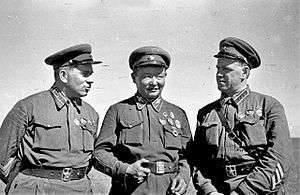
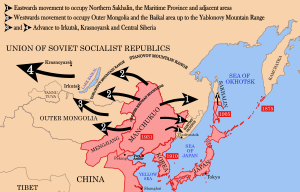
While this engagement is little known in the West, it played an important part in subsequent Japanese conduct in World War II. The battle earned the Kwantung Army the displeasure of officials in Tokyo, not so much due to its defeat, but because it was initiated and escalated without direct authorization from the Japanese government. This defeat combined with the Chinese resistance in the Second Sino-Japanese War,[70] together with the signing of the Nazi-Soviet non-aggression pact (which deprived the Army of the basis of its war policy against the USSR), moved the Imperial General Staff in Tokyo away from the policy of the North Strike Group favored by the Army, which wanted to seize Siberia for its resources as far as Lake Baikal.[71]
Instead, support shifted to the South Strike Group, favored by the Navy, which wanted to seize the resources of Southeast Asia, especially the petroleum and mineral-rich Dutch East Indies. Masanobu Tsuji, the Japanese colonel who had helped instigate the Nomonhan incident, was one of the strongest proponents of the attack on Pearl Harbor. General Ryukichi Tanaka, Chief of the Army Ministry's Military Service Bureau in 1941, testified after the war that "the most determined single protagonist in favor of war with the United States was Tsuji Masanobu". Tsuji later wrote that his experience of Soviet fire-power at Nomonhan convinced him not to attack the Soviet Union in 1941.[72] On 24 June 1941, two days after the war on the Eastern Front broke out, the Japanese army and navy leaders adopted a resolution "not intervening in German Soviet war for the time being". In August 1941, Japan and the Soviet Union reaffirmed their neutrality pact.[73] The United States and Britain had imposed an oil embargo on Japan, threatening to stop the Japanese war effort, but the European colonial powers were weakening and suffering early defeats in the war with Germany; only the US Pacific Fleet stood in the way of seizing the oil-rich Dutch East Indies.[72] Because of this, Japan's focus was ultimately directed to the south, leading to its decision to launch the attack on Pearl Harbor on 7 December of that year. Despite plans being carried out for a potential war against the USSR (particularly contingent on German advances towards Moscow), the Japanese would never launch an offensive against the Soviet Union. In 1941, the two countries signed agreements respecting the borders of Mongolia and Manchukuo[74] and pledging neutrality towards each other.[75] In the closing months of World War II, the Soviet Union would annul the Neutrality Pact and invade the Japanese territories in Manchuria, northern Korea, and the southern part of Sakhalin island.
Soviet assessment
The battle was the first victory for the soon-to-be-famous Soviet general Georgy Zhukov, earning him the first of his four Hero of the Soviet Union awards. The two other generals, Grigoriy Shtern and Yakov Smushkevich, had important roles and were also awarded the Hero of the Soviet Union. They would, however, both be executed in the 1941 Purges. Zhukov himself was promoted and transferred west to the Kiev district. The battle experience gained by Zhukov was put to good use in December 1941 at the Battle of Moscow. Zhukov was able to use this experience to launch the first successful Soviet counteroffensive against the German invasion of 1941. Many units of the Siberian and other trans-Ural armies were part of this attack, and the decision to move these divisions from Siberia was aided by the Soviet spy Richard Sorge in Tokyo, who alerted the Soviet government that the Japanese were looking south and were unlikely to launch another attack against Siberia in the immediate future. A year after defending Moscow against the advancing Germans, Zhukov planned and executed the Red Army's offensive at the Battle of Stalingrad, using a technique very similar to Khalkhin Gol, in which the Soviet forces held the enemy fixed in the center, built up an undetected mass force in the immediate rear area, and launched a pincer attack on the wings to trap the German army.
Following the battle, the Soviets generally found the results unsatisfactory, despite their victory. Though the Soviet forces in the Far East in 1939 were not plagued by fundamental issues to the same extent as those in Europe during the 1941 campaigns, their generals were still unimpressed by their army's performance. As noted by Pyotr Grigorenko, the Red Army went in with a very large advantage in technology, numbers, and firepower, yet still suffered huge losses, which he blamed on poor leadership.[28]
Although their victory and the subsequent negotiation of the Soviet–Japanese Neutrality Pact secured the Far East for the duration of the Soviet-German War, the Red Army always remained cautious about the possibility of another, larger Japanese incursion as late as early 1944. In December 1943, when the American military mission proposed a logistics base be set up east of Lake Baikal, the Red Army authorities were according to Coox "shocked by the idea and literally turned white".[76] Due to this caution, the Red Army kept a large force in the Far East even during the bleakest days of the war in Europe. For example, on July 1, 1942, Soviet forces in the Far East consisted of 1,446,012 troops, 11,759 artillery pieces, 2,589 tanks and self-propelled guns, and 3,178 combat aircraft.[77] Despite this, the Soviet operations chief of the Far Eastern Front, General A. K. Kazakovtsev, was not confident in his army group's ability to stop an invasion if the Japanese committed to it (at least in 1941–1942), commenting: "If the Japanese enter the war on Hitler's side ... our cause is hopeless."[78]
Japanese assessment and reforms
The Japanese similarly considered the result not a failing of tactics, but one that simply highlighted a need to address the material disparity between themselves and their neighbours.[79][80] They made several reforms as a result of this battle: Tank production was increased from 500 annually to 1,200 in 1939. A mechanized headquarters was established in early 1941, and the new Type 1 47 mm anti-tank gun was introduced as a response to the Soviet 45 mm. These cannons were mounted on Type 97 Chi-Ha tanks, resulting in the Type 97 Shinhoto Chi-Ha ("New Turret") variant, which became the IJA's standard medium tank by 1942. IGHQ also dispatched General Tomoyuki Yamashita to Germany in order to learn more about tank tactics, following the crushingly one-sided Battle of France and the signing of the Tripartite Pact. He returned with a report where he stressed the need for mechanization and more medium tanks. Accordingly, plans were put underway for the formation of 10 new armoured divisions in the near future.[81]
Despite all of the above, Japanese industry was not productive enough to keep up with either the United States or the Soviet Union, and Yamashita warned against going to war with them for this reason. His recommendations were not taken to heart, and Japanese militarists eventually successfully pushed for war with the United States. In spite of their recent experience and military improvements, the Japanese would generally continue to underestimate their adversaries, emphasizing the courage and determination of the individual soldier as a way to make up for their lack of numbers and smaller industrial base. To varying degrees, the basic problems that faced them at Khalkhin Gol would haunt them again when the Americans and British recovered from their defeats of late 1941 and early 1942 and turned to the conquest of the Japanese Empire.[31][82]
Also, events exposed a severe lack of procedures for emergency staunching of bleeding. The original Japanese doctrine explicitly forbade first aid to fellow soldiers without prior orders from an officer, and first-aid training was lacking. As result, a large proportion of Japanese dead was due to hemorrhaging from untreated wounds. Furthermore, up to 30% of the total casualties were due to dysentery, which the Japanese believed was delivered by Soviet biological-warfare aerial bombs. To reduce susceptibility to diseases, future Japanese divisions would commonly include specialized Epidemic Prevention and Water Purification Departments.[83] Finally, the Japanese food rations were found to be unsatisfactory, both in packing and in nutritional value.[84]
Legacy
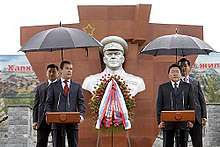
After the Second World War, at the International Military Tribunal for the Far East, fourteen Japanese were charged by delegates of the conquering Soviet Union, with having "initiated a war of aggression ... against the Mongolian People's Republic in the area of the Khalkhin-Gol River" and also with having waged a war "in violation of international law" against the USSR.[85] Kenji Doihara, Hiranuma Kiichirō, and Seishirō Itagaki were convicted on these charges.
Commemoration
The anniversary of the battle was first celebrated in 1969, on the occasion of its 30th anniversary. After its 50th anniversary, in 1989, it dwindled in importance, going down to the level of academic debates and lectures. Only recently has the anniversary made a resurgence as an important event in Mongolian history.[86]
The Mongolian town of Choibalsan, in the Dornod Province where the battle was fought, is the location of the "G. K. Zhukov Museum", dedicated to Zhukov and the 1939 battle.[87] Ulaanbaatar, Mongolia, also has a "G. K. Zhukov Museum" with information about the battle.[88] The latter museum was opened on 19 August 1979 in the presence of Yumjaagiin Tsedenbal and Zhukov's three daughters.[89] During the 70th, 75th and 80th anniversaries of the battle in 2009, 2014 and 2019, respectively, the President of Russia has taken part in the celebrations alongside the President of Mongolia and Soviet and Mongolian veterans, with the celebration often coinciding with a state visit.
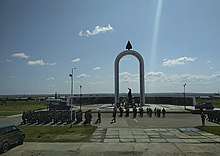
On the 80th anniversary, in 2019, a military parade was held in Choibalsan on Independence Square, which featured tactical formations of the Russian Armed Forces's Eastern Military District and the Mongolian Armed Forces, all of whom were participants in the joint Russian-Mongolian military exercises "Selenga-2019" the previous month.[90][91][92] Parades were held in the federal subjects of Russia that surround and have a close relationship with Mongolia, such as Buryatia, Yakutia and the Altai Republic. In the Buryat capital of Ulan-Ude, a parade was held in the capital.[93][94] In addition, a concert on Sukhbaatar Square took place on 28 August, during which the Russian Alexandrov Ensemble together with the Mongolian singers gave a performance.[95]
In popular culture
The Battles of Khalkhin Gol were depicted in the 2011 South Korean war film My Way. The film was inspired by the allegedly[96] true tale of a Korean named Yang Kyoungjong who was captured by the Americans on D-Day.[97] Yang Kyoungjong was conscripted in the Imperial Japanese Army, fought in the Battles of Khalkhin Gol against the Red Army, then was enlisted to the Red Army, fought against the Germans and, after being taken prisoner, he joined the Wehrmacht.
The Nomonhan Incident casts a shadow over the whole of Haruki Murakami's The Wind-Up Bird Chronicle, although there is little detail about the main battle itself. Two characters who were in the Imperial Japanese Army during the war, relate their experiences in the Mongolian border area at a much later date to the protagonist, which seems to profoundly affect his later adventures.
The Battles of Khalkhin Gol are presented in the video game War Thunder with a map of the area (as well as a historical scenario) and the possibility for players to pilot warplanes used by either side during the battle.
Notes
- Includes at least 57,000 Soviet[1] and 4,860 MPR personnel.[2] Combined Soviet-MPR strength was possibly as high as 74,000.[3]
- 9,703 dead and missing,[14]
15,952 wounded,
2,225 hospitalized due to disease - Japanese military record:
8,440 killed,
8,766 wounded
Soviet claim:
60,000 killed and wounded,
3,000 captured[20]
See the "Aftermath" section.
References
- Kotelnikov p. 109 (2002)
- Khalkhin Gol Battle: the Revision of Statistics. Retrieved 21 June 2015.
- Retrieved 15 Oct. 2015.
- "The Chief Culprit", by Viktor Suvorov,
- Zaloga, p. 13.
- V. Kondratiev, "Khalkhin Gol: War in the Air" retrieved 3 Jan. 2016
- "The Chief Culprit", by Viktor Suvorov, p..
- Coox, p. 580
- "The Khalkhin Gol Battle, 1939" Retrieved 3 Jan. 2016
- Bellamy and Lahnstein (1990) The New Soviet Defensive Policy: Khalkhin Gol 1939 as Case Study Archived 11 December 2016 at the Wayback Machine p. 24
- The cited source here describes Japanese forces after the assault on the Soviets as numbering 28,000 men, and includes Manchukuoan forces. For more information, see the "Aftermath" section.
- Coox, p. 563
- Coox, p. 1168
- M. Kolomiets "Boi u reki Khalkhin-Gol" Frontovaya Illyustratsia (2002)
- Soviet Losses in the Khalkhin Gol Battle. Retrieved 21 July 2015.
- Кондратьев В. Халхин-Гол: Война в воздухе. — М.: Библиотека журнала "Техники – Молодежи". Серия "Авиация", 2002. — 64 с. Тираж 1000 экз.ISBN 5-88573-009-1.
- According to "Soviet Losses in the Khalkhin Gol Battle", these losses break down as: 30 BT-7s, 27 BT-7RTs,2 BT-7As, 127 BT-5s, 30 BT-5RTs, 8 T-26s, 10 KhT-26S, 2 KhT-130S, and 17 T-37s. This does not include tanks that only sustained light to moderate damage, or ones lost due to mechanical failure.
- Coox, p. 576. During one Japanese counterattack alone on the 12/13th of August the MPR 8th cavalry division lost 100 horses captured
- Nomonhan: Japanese-Soviet Tactical Combat, 1939. Leavenworth Papers №2. by Edward J. Drea" Combat Studies Institute, fort Leavenworth, Kansas, 1981
- Glantz, David M.; and House, Jonathan. When Titans Clashed: How the Red Army Stopped Hitler. Lawrence, KS: UP of Kansas, 1995. ISBN 0-7006-0899-0 p. 14.
- Coox, p. 987. Includes 28 120mm–150mm guns and 44 75mm guns.
- Coox, "Nomonhan: Japan against Russia" There are multiple accounts of Japanese trucks being knocked out by Soviet artillery and aviation, as well as losses due to mechanical failures or environmental hazards.
- Drea, Edward J. "Leavenworth Papers No. 2 Nomonhan: Japanese Soviet Tactical Combat, 1939 – MAPS" Archived 7 May 2011 at the Wayback Machine – Retrieved: 13 May 2007.
- Cox, p. 181
- Beevor 2012, pp. 14,18.
- Baabar (1999), pp. 384–86.
- Drea, Edward J. "Leavenworth Papers No. 2 Nomonhan: Japanese Soviet Tactical Combat, 1939 – BIG MAPS – Map 3" Archived 13 November 2011 at the Wayback Machine – Retrieved: 13 May 2007.
- "Áèîãðàôèÿ Ãðèãîðèé Øòåðí". Retrieved 4 March 2015.
- Baabar (1999), pp. 386–87.
- Coox, p. 271
- Timothy Neeno, M.A. Nomonhan: The Second Russo-Japanese War, 2005. – Retrieved: 12 May 2007.
- Coox, p. 1119
- Coox, p. 349
- Coox, p. 350
- Combined Arms Research Library Archived 5 May 2010 at the Wayback Machine
- Drea, Edward J. "Leavenworth Papers No. 2 Nomonhan: Japanese Soviet Tactical Combat, 1939 – BIG MAPS – Map 4" Archived 13 November 2011 at the Wayback Machine – Retrieved: 13 May 2007.
- Combined Arms Research Library: Redeployment Archived 5 May 2010 at the Wayback Machine
- Combined Arms Research Library: Japanese Initiatives Archived 5 May 2010 at the Wayback Machine
- Combined Arms Research Library: Hills 742 and 754 Archived 5 May 2010 at the Wayback Machine
- Drea, Nomhoman, p. 7
- Coox, pp. 578–79
- Coox, pp. 579, 641 note 23
- Coox, p. 590
- Combined Arms Research Library: The Soviet Offensive Archived 5 May 2010 at the Wayback Machine
- Drea, Edward J. "Leavenworth Papers No. 2 Nomonhan: Japanese Soviet Tactical Combat, 1939 – Big Maps – Map 6" Archived 13 November 2011 at the Wayback Machine – Retrieved: 13 May 2007.
- "Leavenworth Papers No. 2 Nomonhan: Japanese-Soviet Tactical Combat, 1939; MAPS". Archived from the original on 7 May 2011. Retrieved 18 April 2011.
- Coox, pg. 578
- Combined Arms Research Library:Japanese Intelligence Failures Archived 5 May 2010 at the Wayback Machine
- Coox, pp. 575–76
- Coox, p. 576
- Coox, p. 577
- Coox, pp. 573–74
- Coox, p. 663
- Combined Arms Research Library: Outcome Archived 5 May 2010 at the Wayback Machine
- Combined Arms Research Library: Encirclement of the 2/28th Infantry Archived 5 May 2010 at the Wayback Machine
- Coox, p. 841
- Goldman pp. 163–64
- Nomonhan: Japan Against Russia, 1939, p. 911
- Steven J. Zaloga, Howard Gerrard, Poland 1939: the birth of Blitzkrieg, Osprey Publishing, 2002, ISBN 1-84176-408-6, p. 80
- Coox, p. 1176
- Drea, p. 9 [p.22 on the linked PDF]
- Kristian Gauthier (2016). "La bataille de Nomonhan et la seconde guerre mondiale en extrème-orient" (PDF). University of Québec at Montreal. p. 87. Retrieved 19 July 2020.
- Kristian Gauthier (2016). "La bataille de Nomonhan et la seconde guerre mondiale en extrème-orient" (PDF). University of Québec at Montreal. p. 87. Retrieved 19 July 2020.
- "Grif sekretnosti sniat': poteri Vooruzhennykh Sil SSSR v voynakh, boevykh deystviyakh i voennykh konfliktakh", pod oshchey redaktsiey G. F. Krivosheeva. (Moskva: Voennoe izd-vo, 1993, ISBN 5-203-01400-0). pp. 77–85.
- Россия и СССР в войнах ХХ века. Книга потерь. Москва, Вече, 2010 ISBN 978-5-9533-4672-6 pp. 158–59, 162
- General-Lieutenant G.F. Krivosheyev (1993). "Soviet Armed Forces Losses in Wars, Combat Operations and Military Conflicts" (PDF). Moscow Military Publishing House. p. 83. Retrieved 21 June 2015.
- Khalkhin Gol Battle: Brief Description and Data Retrieved 20 Jan. 2017. pp. 5–6, 13.
- Nedialkov p. 144
- Nedialkov p. 141
- Beevor, Antony (2012). "16". The Second World War. Weidenfeld & Nicolson.
- Beevor 2012, p. 18.
- Goldman, Stuart (28 August 2012). "The Forgotten Soviet-Japanese War of 1939". The Diplomat.
- Snyder p. 166
- "Declaration Regarding Mongolia" Archived 11 March 2007 at the Wayback Machine, 14 April 1941. – Retrieved: 13 May 2007.
- "The Avalon Project: Documents in Law, History and Diplomacy". Archived from the original on 2 March 2015. Retrieved 4 March 2015.
- Alvin D. Coox, "The Myth of the Kwantung Army", Marine Corps Gazette, 42, no. 7 (July 1958), p. 43
- Glantz, David. "The Soviet Strategic Offensive in Manchuria, 1945: 'August Storm'". Routledge, Aug 2, 2004. p. 8.
- Coox, Nomonhan, p. 1079
- 「"ノモンハン" は日本軍の一方的敗北ではない」三代史研究会『明治・大正・昭和30 の"真実"』文春新書、2003 年、p. 122
- 福井雄三『坂の上の雲に隠された歴史の真実 明治と昭和の歴史の虚像と実像』
- Zaloga, p. 14
- Combined Arms Research Library Archived 5 May 2010 at the Wayback Machine
- Nomonhan: Japan Against Russia. 1939. By Alvin D. Coox, p. 1167
- Nomonhan: Japan Against Russia, 1939. By Alvin D. Coox, p. 1019
- See counts 26 and 36 of the IMTFE indictment, available at http://www.trumanlibrary.org/whistlestop/study_collections/nuremberg/documents/index.php?documentdate=0000-00-00&documentid=18-2&pagenumber=1
- "WHO LOSES IN KHALKHIN GOL BATTLE". www.baabar.mn | Шилдэг нийтлэлчдийн клуб.
- "Cultological Culture". Retrieved 4 March 2015.
- "Embassy of the Russian Federation in Mongolia". Archived from the original on 8 October 2011. Retrieved 1 August 2009.
- "Музей маршала Советского Союза Георгия Константиновича Жукова. Улан-Батор. Монголия". www.legendtour.ru.
- "В Монголии прошел парад в честь 80-летия боев на Халхин-Голе - РИА Новости, 29.08.2019". ria.ru.
- "В Монголии прошел парад в честь 80-летия боев на Халхин-Голе". Яндекс.Новости.
- "В Монголии прошел парад в честь 80-летия боев на Халхин-Голе". asiarussia.ru.
- "Парад в честь 80-летия Победы советских и монгольских войск на реке Халхин-Гол прошел в Улан-Удэ". egov-buryatia.ru.
- "Info". Regnum.ru. 16 September 2019. Retrieved 30 December 2019.
- "80th anniversary of Khalkhin Gol victory celebrated in Mongolia". russkiymir.ru.
- "다시보기 : SBS 스페셜". wizard2.sbs.co.kr (in Korean). Archived from the original on 4 March 2016. Retrieved 6 June 2016.
- A., Morgan; K., Martin (15 May 2014). The Americans on D-Day : a photographic history of the normandy invasion. Minneapolis, MN. p. 135. ISBN 9781627881548. OCLC 874563481.
References
- Baabar, B. (1999). From world power to Soviet satellite: History of Mongolia. University of Cambridge Press. OCLC 318985384
- Beevor, Antony (2012). The Second World War. London: Weidenfeld & Nicolson. pp. 14–19. ISBN 978-0-297-84497-6.
- Coox, Alvin D.: Nomonhan: Japan Against Russia, 1939. Two volumes; 1985, Stanford University Press. ISBN 0-8047-1160-7
- Colvin, John (1999). Nomonhan. London: Quartet Books. ISBN 0-7043-7112-X.
- Drea, Edward: Nomonhan: Japanese-Soviet Tactical Combat, 1939. Leavenworth Papers study for the Combat Studies Institute of the U.S. Army.
- Drea, Edward J. (1998). "Tradition and Circumstances: The Imperial Japanese Army's Tactical Response to Khalkhin-Gol, 1939". In the Service of the Emperor: Essays on the Imperial Japanese Army. Nebraska: University of Nebraska Press. ISBN 0-8032-1708-0.
- Erickson, John (2001). The Soviet High Command: A Military-Political History, 1918–1941. London: Routledge. ISBN 0-7146-5178-8..
- Goldman, Stuart D. Nomonhan, 1939; The Red Army's Victory That Shaped World War II. 2012, Naval Institute Press. ISBN 978-1-59114-329-1. online review
- Hill, Alexander (2017). The Red Army and the Second World War. Cambridge University Press. ISBN 978-1-1070-2079-5..
- Kotelnikov, Vladimir R. Air War Over Khalkhin Gol, The Nomonhan Incident. 2010; SAM publications. ISBN 978-1-906959-23-4.
- Kuromiya, Hiroaki. "The Mystery of Nomonhan, 1939," Journal of Slavic Military Studies (2011) 24#4 pp. 659–77
- Moses, Larry W. "Soviet-Japanese Confrontation in Outer Mongolia: The Battle of Nomonhan-Khalkin Gol," Journal of Asian History (1967) 1#1 pp. 64–85.
- Nedialkov, Dimitar. In The Skies of Nomonhan, Japan vs Russia, May–September 1939. (2nd edition, 2011) Crecy Publishing Limited. ISBN 978-0-859791-52-6.
- Neeno, Timothy: Nomonhan: The Second Russo-Japanese War. MilitaryHistoryOnline.com essay. Uses the Coox book and Drea paper as sources.
- Sella, Amnon. "Khalkhin-Gol: The Forgotten War," Journal of Contemporary History (1983) 18#4 pp. 651–87 in JSTOR
- Snow, Philip. "Nomonhan – the unknown victory," History Today (1990) 40#7 pp. 22–28
- Snyder, Timothy (2010). "Final Solution". Bloodlands: Europe between Hitler and Stalin. New York: Basic Books. ISBN 978-0-465-00239-9.
- Young, Katsu H. "The Nomonhan Incident: Imperial Japan and the Soviet Union," Monumenta Nipponica (1967) Vol. 22, No. 1/2 (1967), pp. 82–102 in JSTOR
- Zaloga, Steven J. Japanese Tanks 1939–45. (2007) Osprey. ISBN 978-1-84603-091-8.
External links
| Wikimedia Commons has media related to Battle of Khalkhin Gol. |
- Topographic Map of the Khalkhin Gol battle area
- Videos of the Nomonhan War Museum
- Warbird Forum – Japan vs. Russia, 1939
- "On the Road to Khalkhin Gol", Part 1 and Part 2, by Henry Sakaida
- Парад в Монголии в честь 80-летия победы на Халхин-Голе
